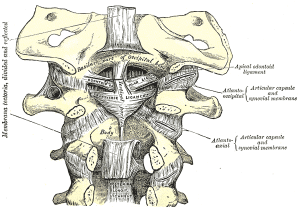
Ligaments Of The Upper Cervical Spine. Joins the body of the axis to the foramen magnum. Magnetic resonance imaging MRI is an essential modality in evaluating the ligamentous and soft tissue elements of the upper cervical spine. There are six major ligaments to consider in the cervical spine. Ligaments that continue from below C7 from anterior to.

Alar and transverse ligaments are both of obvious importance in order to prevent AAS and movement-related spinal cord compression. Anterior and posterior longitudinal ligaments long ligaments that run the length of the vertebral column covering the vertebral bodies and intervertebral discs. It limits flexion and provides an attachment to Trapezius and Splenius capitis. It helps in stability of head and neck especially in head flexion acceleration injuries. The upper cervical spine has the first and second vertebrae the atlas and axis and forms a unit with the occiput. Upper back muscle that is the cervical and thoracic back muscles are divided in three layers.
Ligaments that continue from below C7 from anterior to.
Cervical spine ligaments The cervical spine ligaments are a combination of ligaments that continue from lower regions of the vertebral column that change names as they reach C2 and ligaments that are unique to the cervical spine. Although investigators have analyzed numerous kinematics and musculoskeletal characteristics there are still little data available regarding several suboccipital ligaments such as occipito-atlantal atlantoaxial and cruciform ligaments. The atlas A thick anterior arch remains extending into and joining the two lateral masses on which are the superior atlantal joint facets which articulate with the occipital condyles. Traumatic ligamentous injuries of the atlanto-occipital joint and transverse atlantal ligament are relatively uncommon have a poor prognosis for healing and often respond best to surgical stabilization. It helps in stability of head and neck especially in head flexion acceleration injuries. The neck has seven to 10 ligaments all serving a purpose in the structure and motion of the neck.